Showing Spotlights 1665 - 1672 of 2780 in category All (newest first):
 Engineered nanomaterials present regulators with a conundrum - there is a gut feeling that these materials present a new regulatory challenge, yet the nature and resolution of this challenge remains elusive. But as the debate over the regulation of nanomaterials continues, there are worrying signs that discussions are being driven less by the science of how these materials might cause harm, and more by the politics of confusion and uncertainty. Yet the more we learn about how materials interact with biology, the less clear it becomes where the boundaries of this class of materials called "nanomaterials" lie, or even whether this is a legitimate class of material at all from a regulatory perspective.
Engineered nanomaterials present regulators with a conundrum - there is a gut feeling that these materials present a new regulatory challenge, yet the nature and resolution of this challenge remains elusive. But as the debate over the regulation of nanomaterials continues, there are worrying signs that discussions are being driven less by the science of how these materials might cause harm, and more by the politics of confusion and uncertainty. Yet the more we learn about how materials interact with biology, the less clear it becomes where the boundaries of this class of materials called "nanomaterials" lie, or even whether this is a legitimate class of material at all from a regulatory perspective.
Apr 15th, 2011
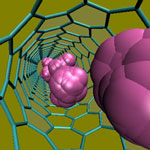 One of the problems in modern separation science and technology is the challenge of separating gaseous mixtures that consist of very similar particles, for example, hydrogen isotope mixtures; mixtures of noble gases; etc. The problem arises because small particles such as hydrogen isotopes share similar size and shape (only their molecular mass is different). While this problem can be technically solved, currently available separation methods such as thermal diffusion, cryogenic distillation, and centrifugation, tend to be time and energy intensive. New theoretical work now shows that narrow carbon nanotubes (CNTs) seem to be an attractive alternative. By using CNTs as nanoporous molecular sieves, the separation of parahydrogen molecules from mixtures of classical particles at cryogenic temperatures seems to be possible.
One of the problems in modern separation science and technology is the challenge of separating gaseous mixtures that consist of very similar particles, for example, hydrogen isotope mixtures; mixtures of noble gases; etc. The problem arises because small particles such as hydrogen isotopes share similar size and shape (only their molecular mass is different). While this problem can be technically solved, currently available separation methods such as thermal diffusion, cryogenic distillation, and centrifugation, tend to be time and energy intensive. New theoretical work now shows that narrow carbon nanotubes (CNTs) seem to be an attractive alternative. By using CNTs as nanoporous molecular sieves, the separation of parahydrogen molecules from mixtures of classical particles at cryogenic temperatures seems to be possible.
Apr 14th, 2011
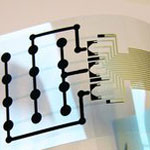 Printed electronics is one of the most important new enabling technologies. It will have a major impact on most business activities from publishing and security printing to healthcare, automotive, military and consumer packaged goods sectors. With recent advances, power and energy storage can be integrated into the printing process, making their potential applications even more ubiquitous. Currently, though, the more complex printed components that require a combination of different class of devices, still experience drawbacks in performance, cost, and large-scale manufacturability. Researchers have now succeeded in fabricating a multi-component sensor array by simple printing techniques - all components (polymer sensor array, organic transistors, electrochromic display) are integrated on the same flexible substrate.
Printed electronics is one of the most important new enabling technologies. It will have a major impact on most business activities from publishing and security printing to healthcare, automotive, military and consumer packaged goods sectors. With recent advances, power and energy storage can be integrated into the printing process, making their potential applications even more ubiquitous. Currently, though, the more complex printed components that require a combination of different class of devices, still experience drawbacks in performance, cost, and large-scale manufacturability. Researchers have now succeeded in fabricating a multi-component sensor array by simple printing techniques - all components (polymer sensor array, organic transistors, electrochromic display) are integrated on the same flexible substrate.
Apr 13th, 2011
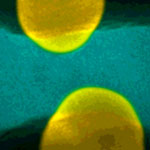 Life as we know it is dominated by friction, the interaction between moving objects. Friction controls our everyday lives, from letting us walk to work, to holding a cup of tea. Friction forces act wherever two solids touch. Although friction has been investigated for hundreds of years - in the 15th century, Leonardo da Vinci was the first to enunciate two laws of friction - it is surprisingly difficult to examine how friction works at the nanoscale level due to the sheer difficulty of bringing nanoscale objects into contact and imaging them at the same time. Researchers have now demonstrated the ability to bring nanoscale objects together, rub them repeatedly across one another and see how friction changes nanosized materials in real time.
Life as we know it is dominated by friction, the interaction between moving objects. Friction controls our everyday lives, from letting us walk to work, to holding a cup of tea. Friction forces act wherever two solids touch. Although friction has been investigated for hundreds of years - in the 15th century, Leonardo da Vinci was the first to enunciate two laws of friction - it is surprisingly difficult to examine how friction works at the nanoscale level due to the sheer difficulty of bringing nanoscale objects into contact and imaging them at the same time. Researchers have now demonstrated the ability to bring nanoscale objects together, rub them repeatedly across one another and see how friction changes nanosized materials in real time.
Apr 12th, 2011
 Life cycle assessment is an essential tool for ensuring the safe, responsible, and sustainable commercialization of a new technology. With missing data about the large scale impact of nanotechnology, life cycle assessments of potential nanoproducts should form an integral part of nanotechnology research at early stages of decision making as it can help in the screening of different process alternatives. Part of any meaningful results from a life cycle assessment is the total quantity of the material under investigation. Especially exposure assessments often begin with estimates based on total amounts of a material produced with the assumption that some fraction of the material in question will ultimately released to the environment. As it turns out, nobody - no research institution, no government agency, no industry association - knows even vaguely how much nanomaterials are manufactured today.
Life cycle assessment is an essential tool for ensuring the safe, responsible, and sustainable commercialization of a new technology. With missing data about the large scale impact of nanotechnology, life cycle assessments of potential nanoproducts should form an integral part of nanotechnology research at early stages of decision making as it can help in the screening of different process alternatives. Part of any meaningful results from a life cycle assessment is the total quantity of the material under investigation. Especially exposure assessments often begin with estimates based on total amounts of a material produced with the assumption that some fraction of the material in question will ultimately released to the environment. As it turns out, nobody - no research institution, no government agency, no industry association - knows even vaguely how much nanomaterials are manufactured today.
Apr 11th, 2011
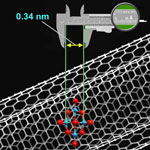 Metrology is the science of measurements, and nanometrology is that part of metrology that relates to measurements at the nanoscale. Many governments worldwide have existing nanotechnology policies and are taking the preliminary steps towards nanometrology strategies, for example in support of pre-normative R+D and standardization work. In this Nanowerk Spotlight, we look at the European Commission funded project Co-Nanomet as an example of the importance of nanometrology as a key enabling technology for quality control at the nanoscale. While a first and obvious benefit of metrology is its potential to improve scientific understanding, a second, equally important, but less obvious benefit of metrology is closely linked to the concepts of quality control or conformity assessment, which means making a decision about whether a product or service conforms to specifications.
Metrology is the science of measurements, and nanometrology is that part of metrology that relates to measurements at the nanoscale. Many governments worldwide have existing nanotechnology policies and are taking the preliminary steps towards nanometrology strategies, for example in support of pre-normative R+D and standardization work. In this Nanowerk Spotlight, we look at the European Commission funded project Co-Nanomet as an example of the importance of nanometrology as a key enabling technology for quality control at the nanoscale. While a first and obvious benefit of metrology is its potential to improve scientific understanding, a second, equally important, but less obvious benefit of metrology is closely linked to the concepts of quality control or conformity assessment, which means making a decision about whether a product or service conforms to specifications.
Apr 8th, 2011
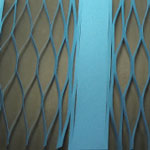 Many strategies to develop stretchable electronics rely on engineering new constructs from existing materials, e.g. ultrathin, stretchable silicon structures. Another approach is to fabricate ultrathin CMOS circuits on stretchable materials such as polymers. Nanotechnology allows a novel route to materials and structures that can be used to develop human-friendly devices with realistic functions and abilities that would not be feasible by mere extension of conventional technology. New research suggests devices that can act as part of human skin or clothing, and can therefore be used ubiquitously. Such devices could eventually find a wide range of applications in recreation, virtual reality, robotics and health care.
Many strategies to develop stretchable electronics rely on engineering new constructs from existing materials, e.g. ultrathin, stretchable silicon structures. Another approach is to fabricate ultrathin CMOS circuits on stretchable materials such as polymers. Nanotechnology allows a novel route to materials and structures that can be used to develop human-friendly devices with realistic functions and abilities that would not be feasible by mere extension of conventional technology. New research suggests devices that can act as part of human skin or clothing, and can therefore be used ubiquitously. Such devices could eventually find a wide range of applications in recreation, virtual reality, robotics and health care.
Apr 6th, 2011
 A few years ago, researchers determined that the stiffness of cancer cells affects the way they spread. When cancer is becoming metastatic, or invading other organs, the diseased cells must travel throughout the body. Because the cells need to enter the bloodstream and maneuver through tight anatomical spaces, cancer cells are much more flexible, or softer, than normal cells. With this knowledge, researchers wanted to understand the cell mechanics associated with the anticancer treatment of cells from patient samples; in particular they were interested in reporting the effects of green tea extract due to the fact that is was a natural product, it has know anti-cancer effects and it is widely consumed in beverage form around the world.
A few years ago, researchers determined that the stiffness of cancer cells affects the way they spread. When cancer is becoming metastatic, or invading other organs, the diseased cells must travel throughout the body. Because the cells need to enter the bloodstream and maneuver through tight anatomical spaces, cancer cells are much more flexible, or softer, than normal cells. With this knowledge, researchers wanted to understand the cell mechanics associated with the anticancer treatment of cells from patient samples; in particular they were interested in reporting the effects of green tea extract due to the fact that is was a natural product, it has know anti-cancer effects and it is widely consumed in beverage form around the world.
Apr 5th, 2011
 Engineered nanomaterials present regulators with a conundrum - there is a gut feeling that these materials present a new regulatory challenge, yet the nature and resolution of this challenge remains elusive. But as the debate over the regulation of nanomaterials continues, there are worrying signs that discussions are being driven less by the science of how these materials might cause harm, and more by the politics of confusion and uncertainty. Yet the more we learn about how materials interact with biology, the less clear it becomes where the boundaries of this class of materials called "nanomaterials" lie, or even whether this is a legitimate class of material at all from a regulatory perspective.
Engineered nanomaterials present regulators with a conundrum - there is a gut feeling that these materials present a new regulatory challenge, yet the nature and resolution of this challenge remains elusive. But as the debate over the regulation of nanomaterials continues, there are worrying signs that discussions are being driven less by the science of how these materials might cause harm, and more by the politics of confusion and uncertainty. Yet the more we learn about how materials interact with biology, the less clear it becomes where the boundaries of this class of materials called "nanomaterials" lie, or even whether this is a legitimate class of material at all from a regulatory perspective.
 Subscribe to our Nanotechnology Spotlight feed
Subscribe to our Nanotechnology Spotlight feed





